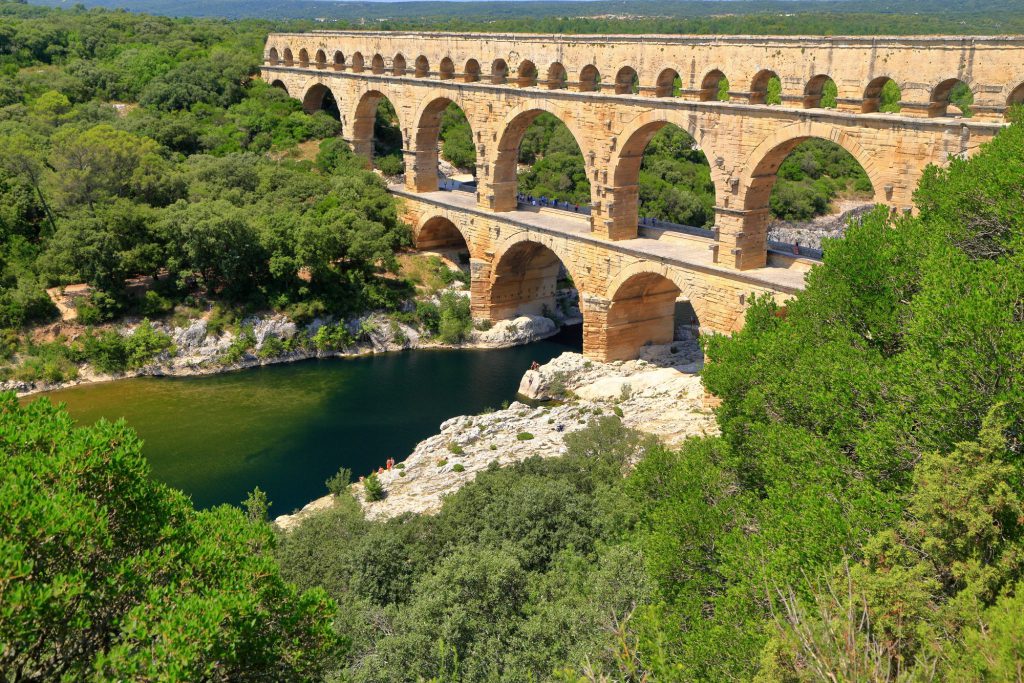Financial Mail Travel
Bonne Chance
The plane shuddered as its landing gear jolted out. Budget air travel has edge, not to mention the mild tension evoked by having a pilot who looked barely out of high school. Ahead of us, on a scorched plain, Nîmes Airport loomed unimposingly, blue heat simmering on all sides. We touched down quite successfully, but without accompanying cheers and clapping of hands. No, that bit of fun is reserved for Italy and Spain, Croatia perhaps. France is the Mediterranean’s demure sibling after all. Internal locus of joy. Chic.
I never actually planned to go to Nîmes in the south of France. It happened by accident, a trick of fate. Living in London, I needed to renew my Schengen visa fast – a task best done at the French consulate, I was told. To really cut through the red tape, though, would require a trip to France. I’d been to Paris and felt like something rural, outdoorsy. Quick research revealed cheap flights to Nîmes, an ancient Roman city just outside Provence with an aqueduct and a river in which to swim.
I pictured rustic-looking Frenchmen skulking through the streets with baguettes under their arms and sighed. I was sold.
Descending over the jagged Garrigues de Nîmes, neck craned, I saw it from my window seat: pale arches stretching Lego-small in the wilderness below. Pont du Gard! The highest elevated Roman aqueduct, or so tourist websites claim. In effect, Pont du Gard is a bridge over the Gardon River, part of an aqueduct built roughly seven years after Jesus is said to have died. Dropping 17 metres over 50 kilometres, it led spring water to the Roman colony of Nemausus, today Nîmes.
Stepping off the plane, summer hit me in the face. The ground staff were pretty steamy too, like figures from a Serge Gainsbourgesque music video. It was a languid choreography: men tossing dishevelled hair; placid nonchalance behind Ray-Ban sunglasses as they loaded suitcases, nodding passengers along. “Merci,” I said. The man nodded again; he nearly smiled.
At Nîmes Airport, a naval air base really, the bus service covering the nine-kilometre stretch into the city is scheduled to coincide with the sprinkling of daily commercial flights. Our plane had arrived late, so we missed our bus.
It took us – a handful of stranded, heat-stroked travellers – just under half an hour to coax said information out of an airport official-cum-taxi merchant.
It took some courageous broken French to successfully summon a taxi and we all piled in, squeezed tightly, bouncing over potholed roads past cypress trees toward the city.
Make no mistake, the outskirts of Nîmes are grim. The usual strip clubs, strip malls, franchise stores with dizzying consumer billboards. A broken truck or two. But as we neared the heart of the city, charm set in. Pulling up next to the railway station, we alighted next to broad white arches, a large, stately centrepiece clock gazing down like Caesar. By now I was late to meet my Airbnb host, a man of brusque communication from whom I was renting an apartment in the historic centre, wherever that was.
Hotfooting it up the Avenue Feuchères, tree-lined but boiling in the shade, I crossed the main city square, Esplanade Charles-de-Gaulle, past the marble Fontaine Pradier with its nether-ogling statues. A spectacular sight unfurled to my left: the Arènes de Nîmes, the city’s old amphitheatre, sunbathed and gleaming, immaculately preserved and reminiscent of some Herculean Asterix and Obelix caper. Indeed, in central Nîmes you can’t swing a cat without hitting some ancient Roman relic.
its nether-ogling statues. A spectacular sight unfurled to my left: the Arènes de Nîmes, the city’s old amphitheatre, sunbathed and gleaming, immaculately preserved and reminiscent of some Herculean Asterix and Obelix caper. Indeed, in central Nîmes you can’t swing a cat without hitting some ancient Roman relic.
Cafés and restaurants spilled onto the square and I entered the nearest gelato shop: “Wi-Fi?” “Oui,” the waitress nodded. Wi-Fi, I had learned, is all you need to survive solo travel in Europe. Well, Wi-Fi and cheese. On my phone, I extracted my accommodation’s address, then veered onto Google Maps. “Merci!”
Suitcase rattling and phone aloft like the guiding staff of Moses, I dashed through the maze of streets, across cobblestoned squares quaint like postcards, past tables and umbrellas, lingerie stores, shoe shops, shops selling hair extensions and okra per kilo. My quarters were on the “African side” of the historical centre. On my trip to Paris I had noticed a similar thing in Montmartre – a flourishing Francophone cuisine and market scene. Stopping in front of a cream-coloured building, breathless, I pushed the intercom button: “Damdy, hi?”
The foyer was dim with a black-and-white checkerboard floor; a staircase with a heavy mahogany banister curved up. On the third floor, Damdy – a softening middle, and the bluest eyes – opened the door to a sun-flooded apartment, with large windows overlooking street bustle and letting in the breeze. Turned out Damdy owns a boulangerie or bakery down the road. Responding to a question on the French baguette-under-the-arm stereotype, he shrugged. “A practical way to carry your daily bread, no?” He recommended some restaurants, pointing out a nearby South African eatery: L’Esclafidou, with Cape Malay curry and chakalaka cod. But I wasn’t there for South African food.
I asked my practically-minded host how to best eat French? Brow furrowed, he relayed the expression “à la bonne franquette”: to eat simply, without much organisation or money – sausage, bread, cheese and a bottle of wine. Good food, friends, and the joy of a moment shared. From the depth of his brow, I understood the depth of the French connection to eating; they don’t just love food, they respect it, along with the people who are a part of the process – the bakers, farmers, cooks and friends.
After a nap, I headed out and followed Damdy’s advice on simplicity: dinner was Camembert, baguette, olives and baby tomatoes, a picnic shared with swans at the Jardins de la Fontaine, next to chestnut trees and cedars. Again I wandered the streets, this time at leisure, ending up at a square flanking Maison Carrée – a Vitruvian temple with six giant, front-facing columns, rough and cool to the touch – for a nightcap carafe of Merlot.
The next morning, I retraced my steps to Gare de Nîmes to catch the B51 bus to Pont du Gard, 20 kilometres away. The road rolled over gold flats under big, blue sky– the palette that inspired some of Vincent van Gogh’s most famous paintings including Sunflowers and The Starry Night. The road started twisting as we crossed into the Garrigues de Nîmes, curving past high shrubs and sycamore trees.
Entering Pont du Gard costs 8€, a point of contention. The French love to complain. They even have a verb for it: râler which means “to moan with low-key anger at something you cannot change”. In The Little Prince, Antoine de Saint-Exupéry said it well: “I like my misfortunes to be taken seriously.”
After a 20-minute hike, standing on a pebble river beach gazing up at the three-tier bridge, 275 metres long, my heart lurched. The arc of history felt visceral right then – long, paved in blood, majesty and madness. Standing on the same spot three centuries ago, philosopher Jean-Jacques Rousseau remarked, “This time the object surpassed my expectation, for the only time in my life.” Reflecting on Pont du Gard, English author Hilaire Belloc wrote of “Its isolation, its dignity, its weight”.
Around me, families splashed, chatting and eating sandwiches. I spent the better part of the afternoon there, then walked along deserted country roads, before catching the B51 bus back into the city. Inexplicably, that day the molecules aligned. Bonne chance.






 Sign-up and receive the Business Media MAGS newsletter OR SA Mining newsletter straight to your inbox.
Sign-up and receive the Business Media MAGS newsletter OR SA Mining newsletter straight to your inbox.